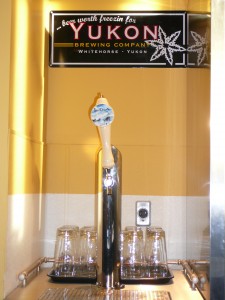A few weeks ago I wrote a post discussing how beer flavour and aroma can be transformed simply by its serving method. I got a second opportunity recently to contemplate the effects of dispensation mode, in this case the keg vs. bottle. Two weeks ago the official opening of the new Urban Diner on 109 Street offered Yukon’s Lead Dog Ale on tap – a first for anywhere outside Whitehorse. I popped by for a pint, obviously.
What I experienced was very interesting. Lead Dog is a very good example of an English Old Ale – dark, hearty and warming. I reviewed it in Vue Weekly last year (read that here); quite a positive review, if I may say so. Here is a key excerpt:
The aroma is a lovely blend of chocolate, rich caramel, toffee and dark fruit aromas of raisin, plum and cherry. In the taste, the sweetness starts delicate but builds as the beer moves across your tongue. Before it gets too sweet, a dry, light roastiness kicks in to balance the beer off. The soft roast lingers in the aftertaste.
The draft version maintains the strong dark fruit, some chocolate and caramel sweetness. It also continues to dry out in the finish, preventing it from being cloying. However, the overall impression of the beer is softer and more mellow. I notice the alcohol less, and the roastiness slid into the background. In general it becomes less “wintery” in its impression and seems to have more in common with a robust porter or a bigger dark brown ale.
“But”, I can hear you saying, “they are different batches made a year apart!” True. So to be sure, later that night I headed over to the Rocky Mountain Wine and Food Festival (which I wrote about here), where Yukon had a booth. I sampled the bottled version and found, pretty well, the same beer I reviewed last year. The roast was bigger, as was the alcohol warming and it was sharper. Now, this isn’t as scientific as a side-by-side test, but it is pretty damned close – only a couple of hours difference.
Why the difference? It comes down to keg vs. bottle. My experience (and I would be happy to have a professional chime in on this) is that keg beer has a softer carbonation, with tighter carbon dioxide beads, and that certain aromas and flavours come out while others drop away a bit. My theory has two parts. First there is the bulk packaging. Kegs, with their larger size, allow for higher quality aging – where flavours can blend and mellow (much like bulk aging vs. bottle aging wine or port). Beer matures in the bottle, but the smaller volume changes the effects of time. This effect can be relevant even for young and delicate beer, as even a few days can make a difference. Second, the effect of pushing the beer through tap lines (with CO2) affects how it tumbles into the glass. The head is generally thicker (trapping more aroma) and, in my opinion, softens the mouthfeel.
Now, I am not a microbiologist, and so won’t work above my pay grade to try to explain WHY all of that might be. I just observes it, kids. I leave it to the really smart people to explain the whys and wherefores.
As for me, give me another Lead Dog – in the bottle or on tap, I don’t care.
As for the Urban Diner, I promised a take on their beer list. My conclusion is “focused on quality”. It isn’t a long list (about 12 beer), but it is well-thought out and almost every beer on it is of unquestioned quality. On the light end they have Steam Whistle and Yukon’s Fireweed, moving into, Cannery Nut Brown Ale and St. Ambroise Oatmeal Stout and Pike’s Kiltlifter. They can also boast (for the moment) that they are Alberta’s only source for R&B Brewing. They offer 3 of the Vancouver brewery’s beer, including their staple Raven Cream Ale. And since they are clearly aiming for a quieter, more appreciative crowd, you won’t have to jostle with Whyte Ave rowdies to give it a try.

